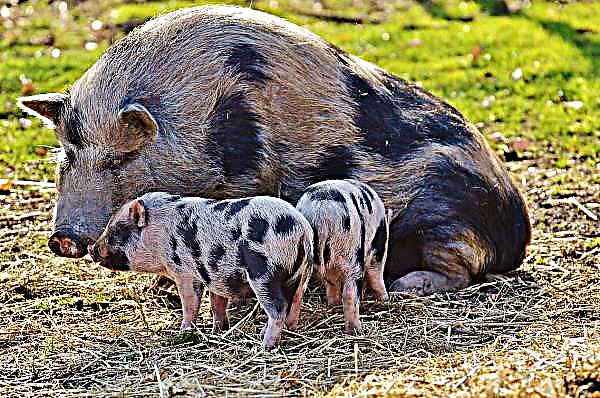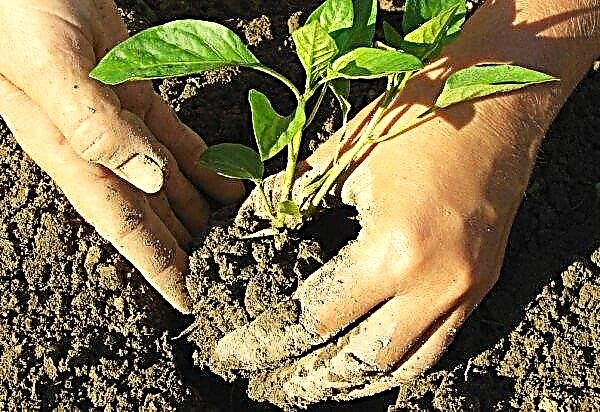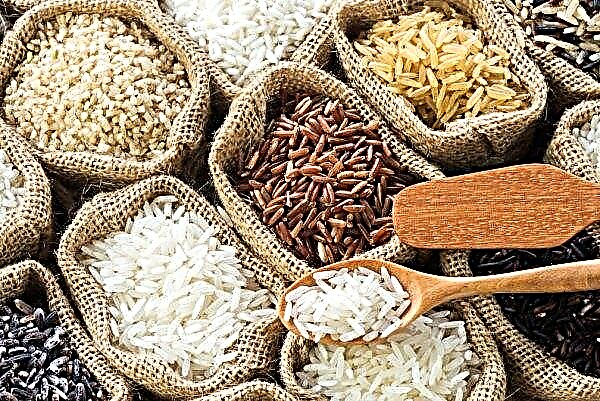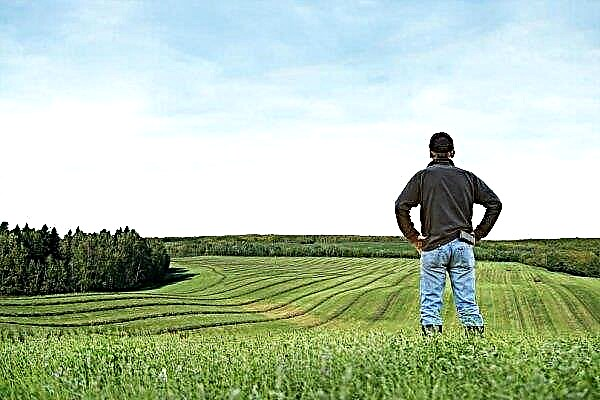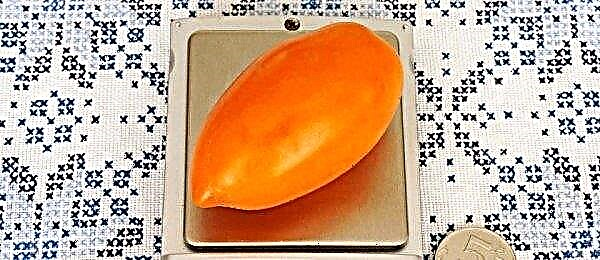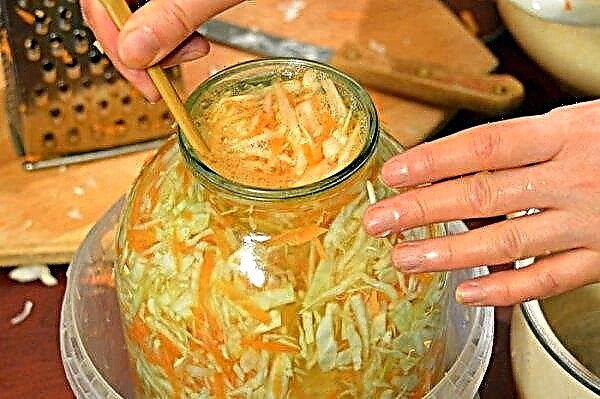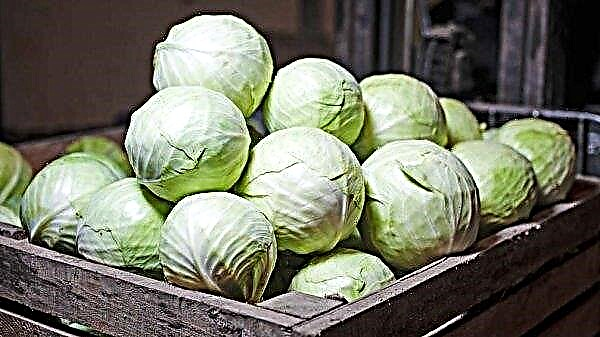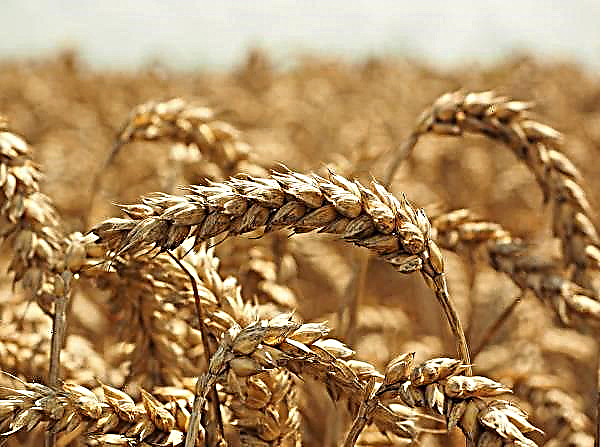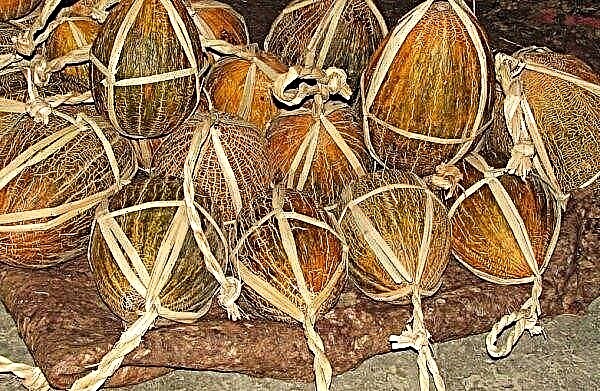Roses are often grown in summer cottages with a decorative purpose, but after plentiful and prolonged flowering, the bushes need to regain their strength. To do this, in the fall they are fed with various fertilizers, which contribute to the lush flowering of roses in the next year. Our article lists the main reasons why you should not forget about fertilizing the bushes in the fall, the timing and rules of fertilizing, as well as the peculiarities of autumn care for roses and their preparation for wintering.
Why feed roses in the fall?
Traditionally, roses are fed with fertilizers in the spring, before flowering, but over the summer the soil around the bushes is significantly depleted. After a winter dormant period in spring, rose bushes begin their active growth long before they can be fertilized.
Did you know? Fragrant rose oil is used to make 98% of women's and 48% of men's perfumes.
Accordingly, it is recommended to make fertilizers for these plants in the fall - nutrients are sure to come in handy for the plant in early spring. The main reasons for the autumn feeding of roses are listed below:
The main reasons for the autumn feeding of roses are listed below:
- strengthening the roots of the plant before the onset of cold weather;
- enrichment of the soil with essential minerals;
- restoration of bushes after autumn pruning;
- increased frost resistance of roses;
- strengthening the immunity of bushes before diseases;
- increasing the resistance of plants to pest attacks.
Proper fertilizing in the fall is the key to lush flowering roses next year.
Signs of Nutrition Deficiency
To determine that rose bushes do not receive all the necessary nutrients from the soil, it is easy by the appearance of the plants. But in order to choose the right fertilizer, you need to know which substances roses need. The deficit of each element is accompanied by certain changes in the appearance of the bushes.
The main symptoms of a lack of fertilizer are listed below:
- the appearance of reddish spots on the leaves, the curvature of shoots and premature fall of foliage indicate a lack of nitrogen;
- small and weak dark green leaves with a red-violet lower part are a sign of phosphorus deficiency;
- dried brown edges of green leaves, a reddish shade of young leaves and small flowers on the bush indicate insufficient potassium;
- if the central part of the leaf becomes pale and gradually begins to die, causing extensive premature fall of the green mass of the bush, then this is a sign of a lack of magnesium;
- large yellow spots, which gradually spread over the entire surface of the leaf and provoke wilting of the bush, indicate a lack of iron;
- if yellow streaks appear between the veins on the leaves, this indicates a lack of manganese.
 When these signs appear, liquid solutions of complex fertilizers are prepared for roses and irrigated with bushes. The concentration of such a solution should be 2 times less than that indicated on the package.
When these signs appear, liquid solutions of complex fertilizers are prepared for roses and irrigated with bushes. The concentration of such a solution should be 2 times less than that indicated on the package.Feeding Dates
You need to start fertilizing immediately after the flowering period. In autumn, plant nutrition is carried out in two stages: in early September, and then again - in early October.
At the first stage, both liquid and dry fertilizers can be used. In early October, the air temperature drops, so spraying and watering roses with liquid solutions can harm plants and cause rotting of the root system. Therefore, at the second stage it is recommended to use only granular and dry top dressing.
Organic fertilizer
In autumn, it is not worth abusing organic fertilizers for roses. Most of them contain nitrogen, which will cause rapid growth of young shoots of the bush. Such young branches will be most vulnerable to the effects of cold weather and may cause decay of the entire plant.
Organic flowers are recommended to be fed only once - in September, using one of the components listed below in the article.
Ash
This component is necessary for roses and can be used in the form of powder or aqueous solution. Ash does not contain nitrogen, but it is a source of many useful elements - magnesium, calcium, boron, sodium. The rules for fertilizing rose bushes with ash are listed below:
The rules for fertilizing rose bushes with ash are listed below:
- For foliar treatment of plants, an aqueous ash solution (200 g of substance per 10 l of water) is prepared, which is sprayed with bushes in the morning or evening hours.
- Irrigation of bushes can not be carried out in bright sunlight and at dusk, since in the first case, the solution will leave burns on the leaves, and in the second it can cause fungal infections.
- In dry form, wood ash is used to till the soil around plants - about 1 liter of powder is consumed per 1 m².
- For watering, an aqueous ash solution (100 g of substance per 10 l of water) is prepared - the product is infused for a week, and then applied under the root in an amount of 0.5 l per plant.
Compost
This substance will not only provide the roots of roses with essential nutrients, but also protect plants from winter frosts. It is recommended to use compost during repeated autumn top dressing, spreading it evenly around the bushes. It is not necessary to sprinkle fertilizer with earth - compost will slowly decompose throughout the winter, giving nutrients to the roots. The average consumption rate of this fertilizer is 4 kg per 1 m².
It is not necessary to sprinkle fertilizer with earth - compost will slowly decompose throughout the winter, giving nutrients to the roots. The average consumption rate of this fertilizer is 4 kg per 1 m².
Did you know? One of the most amazing varieties are Chameleon roses - in the afternoon these flowers have a rich red color, and when night falls they turn white.
Onion peel
The composition of this fertilizer includes vitamins and phytoncides, which increase the immunity of roses and protect them from diseases and pests. You can use onion peel as a top dressing in various ways:
You can use onion peel as a top dressing in various ways:
- For spraying, prepare a decoction - add 2 cups of husk per 10 liters of water, bring the mixture to a boil and let it brew for 4 hours. Chilled broth irrigate roses.
- To water the plants, use an infusion - onion peel is poured with warm water (2 l of liquid per 500 g of husk), covered with a lid and left for 24 hours. About 500 ml of liquid infusion is applied under one bush.
- You can add a little onion husk to the compost by spreading fertilizer on the ground around the plants.
Manure
Fresh manure contains a lot of nitrogen and various harmful microorganisms, so in its pure form it can not be used to feed flowers in the fall. But other organic fertilizers can be prepared from this ingredient. The main ways to use manure to fertilize rose bushes are listed below:
The main ways to use manure to fertilize rose bushes are listed below:
- Compost can be made from this fertilizer - for this you need to build a wooden container with a lid and put manure in it, pouring each layer with a small amount of earth. As a result of decomposition processes, the temperature of the mixture rises to + 70 ° C, so in a year you can get high-quality compost.
- Manure can be used to obtain humus - for this it needs to be put in a heap and left for 1-2 years to get rid of excess ammonia. Ready humus is laid around plants to increase soil fertility. 3-4 kg of humus is enough for 1 m².
- A concentrated solution of mullein can be obtained from manure if it is diluted with water in a ratio of 1:10. The remedy must be insisted for a week, and before watering the plants, dilute it with water in a ratio of 1: 2. It is recommended to apply 0.5 l of fertilizer to each bush.
Bird droppings
In its pure form, fresh litter contains a lot of nitrogen, but it also contains useful trace elements - zinc, magnesium, sulfur, potassium, etc. The specified substance will help enrich the soil with nutrients, but it must be used with caution so as not to burn the roots. The main methods for preparing organic fertilizer from bird droppings are listed below:
The main methods for preparing organic fertilizer from bird droppings are listed below:
- The substance can be used to prepare liquid root dressing - for this, rotted litter is diluted with clean water at a ratio of 1:10 and each bush is watered with 400-500 ml of this solution.
- If only fresh bird droppings are available, then it is diluted with large amounts of water (20 parts of the liquid per 1 part of the substance) to reduce the high concentration of ammonia.
- You can use the rotted litter in a dry form - for this you need to mix it with the same amount of earth and put it around the rose bushes.
Important! In dry form, rotted litter will not only nourish the roots of the plant, but also provide them with additional insulation in the cold season.
Mineral fertilizers
After prolonged flowering, pink bushes are weakened and need to be restored, so before wintering it is recommended to fertilize them well with minerals that will help plants better survive the winter and give them strength for active growth in spring.
Mineral fertilizers are applied twice - in September and October. The main requirement for such autumn top dressing is a high content of potassium and phosphorus.
Potash
As a source of potassium, you can use kalimagnesia (contains potassium, sulfur and magnesium). Feeding roses with this fertilizer strengthens the stems of plants, increases the number of buds and protects them from fungal infections. The rules for using kalimagnesia for feeding roses are listed below:
The rules for using kalimagnesia for feeding roses are listed below:
- At the end of September, you can prepare a basic solution for spraying bushes - for this, 20 g of the substance is dissolved in 10 l of water. For irrigation of roses on an area of 1 m², 5 l of the resulting solution is enough.
- The second top dressing is recommended to be applied in a dry form - for this, a small groove is dug around a bush at a distance of about 20 cm, into which Kalimagnesia powder is added. Fertilizer consumption rate per 1 m² - 20 g.
Important! Excess potassium in the soil leads to the fact that the flowering of roses begins later than the deadline, and some buds remain underdeveloped and rot, so you need to clearly follow the instructions for the use of fertilizers.
Potassium phosphorus
This group of fertilizers is very important for bushes, as it helps them successfully survive the effects of low temperatures and a long winter, increases the resistance of roses to diseases and helps strengthen the trunk. Potassium phosphate fertilizer options are listed below:
Potassium phosphate fertilizer options are listed below:
- For watering plants, you can prepare a mixture by dissolving 15 g of potassium monophosphate and superphosphate in 10 l of water. The indicated amount of solution is enough to treat an area of 5 m².
- To stimulate the fast lignification of the stem, you can use a phosphorus concentrate prepared from 50 g of superphosphate and 1 liter of hot water (temperature + 65 ° C). The resulting product is diluted with clean water in a ratio of 1:10 and used to spray the bushes.
- To prepare a nutritious root dressing, you can mix 10 g of potassium sulfate, 25 g of superphosphate and 2.5 g of boric acid, and then dissolve them in 10 l of water. For watering one bush, it is recommended to use 1 liter of fertilizer.
- In October, it is better to give preference to dry potash-phosphorus fertilizers - a small trench is dug around each bush and 30 g of potassium sulfate and 40 g of superphosphate granules are placed in it. Then a little water is poured into the trench and sprinkled with earth so that the introduced substances dissolve well in the soil.
Nitrogen
To apply nitrogen fertilizers under rose bushes in autumn is not recommended. They cause a continuous growth of green mass, as a result of which the bush cannot go into a winter state of dormancy for a long time and is wasting its energy on growing leaves.
They cause a continuous growth of green mass, as a result of which the bush cannot go into a winter state of dormancy for a long time and is wasting its energy on growing leaves.
Did you know? Rose is a national flower in the USA, Iran and England.
Folk remedies for autumn dressing roses
In addition to the fertilizers listed above, roses can be successfully fed with folk remedies. They do not contain chemicals, but significantly improve the composition of the soil and are of low cost.
The basic rules for plant nutrition by folk methods are listed below:
- Yeast solution for irrigation - prepared from 10 g of dry yeast, 10 l of warm water and 40-50 g of sugar. The tool is insisted for two hours, and then diluted with clean water in a ratio of 1: 5.
- Banana peel - it is buried in the soil near the bush and used as a natural source of potassium.
- Crushed egg shells - the product is mixed with a small amount of earth and laid out around the plants. For 1 m², it is recommended to use 2 cups of crushed product.
- Coffee grounds - the product must be distributed on the surface of the earth around the bushes, and then loosen the soil, mixing it with the grounds. This fertilizer contains calcium, magnesium and potassium.
- Used tea leaves - mixed with soil around the bushes, contains a lot of useful trace elements.
Features of caring for roses in the fall
In addition to feeding, in the autumn period it is necessary to carry out preventive measures against diseases that can affect plants in the cold season.
For the winter, it is recommended to build a shelter for the bushes that will prevent freezing of their roots and branches, as well as protect thin shoots from damage under the weight of snow and gusts of cold wind.
Disease prevention
In the cold season, roses are most vulnerable to diseases and infections.
To prevent infection of the bushes, in the fall, a number of preventive measures are carried out, which include:
- timely top dressing with fertilizers;
- mandatory removal of leaves before sheltering plants;
- spraying bare branches of a plant with a 3% solution of iron sulfate;
- fungicides can be used instead of vitriol, using them according to the instructions on the package.

Preparation for warming roses
In order for the bushes to successfully winter and delight with lush flowering with the onset of heat, it is necessary not only to protect them well from frost, but also to properly prepare the plants for winter.
The basic rules for preparing roses for warming are listed below:
- from the beginning of September, you need to stop watering the roses so as not to oversaturate the soil around the roots with moisture;
- to stop the active growth of young shoots, you need to pinch their edges in early September;
- to avoid the autumn awakening of sleeping buds on the trunk, the procedure of loosening the soil around roses in autumn is not carried out;
- in the second half of September, buds, weak and unripe shoots, as well as branches that grow inside the bush, are removed;
- pruning and burning of all leaves is carried out at the end of October;
- in early November, it is recommended to spud plant trunks to protect them from frost. However, if the winter in your region is accompanied by numerous thaws and rains, then the hilling can cause rotting of the bush, therefore it is better to refuse this procedure;
- in mid-November, the branches of the bushes are moved to a horizontal position, gradually tilting them to the ground - this will help protect the fragile shoots from breaking and will help to better cover them. Between the lowered branches of the bush and the ground lay a layer of foam or wooden boards.
Shelter of roses
The essence of this procedure is to create an additional air gap between the shoots of the bush and the environment.
On the one hand, it should protect the branches of roses from cold air, and on the other, to prevent them from rotting. Basic shelter rules are listed below:
Basic shelter rules are listed below:
- it is best to pull the covering material over pre-installed arcs placed above the branches of the plant;
- usually roses are sheltered in late November after a stable temperature of about 0 ° C is established on the street;
- for sheltering plants, a dense spanbond or fir spruce branch is used - it is laid out on prepared arcs;
- a water-repellent layer of roofing material or thick cardboard is laid on top of the covering material;
- last year's leaves and snow can be poured onto the top layer of the shelter for better protection from subzero temperatures;
- if thaws often occur in winter, then plants need to be aired so that they do not bar. To do this, the shelter is slightly raised, providing plants with fresh air for the daytime;
- in spring, roses can be freed from shelter only after the threat of frost below –10 ° C disappears. Protection is removed gradually, starting with regular airing during the day.
Important! You can not use a film as a covering material for roses - it does not hold well on the bushes, and if fixed, it prevents air circulation around the plants.
Proper cultivation of roses on the site helps to decorate its territory with lush flowering bushes. In order for plants to please you with large and beautiful flowers with the onset of heat, you need to timely feed in the fall in accordance with the recommendations listed in the article.

